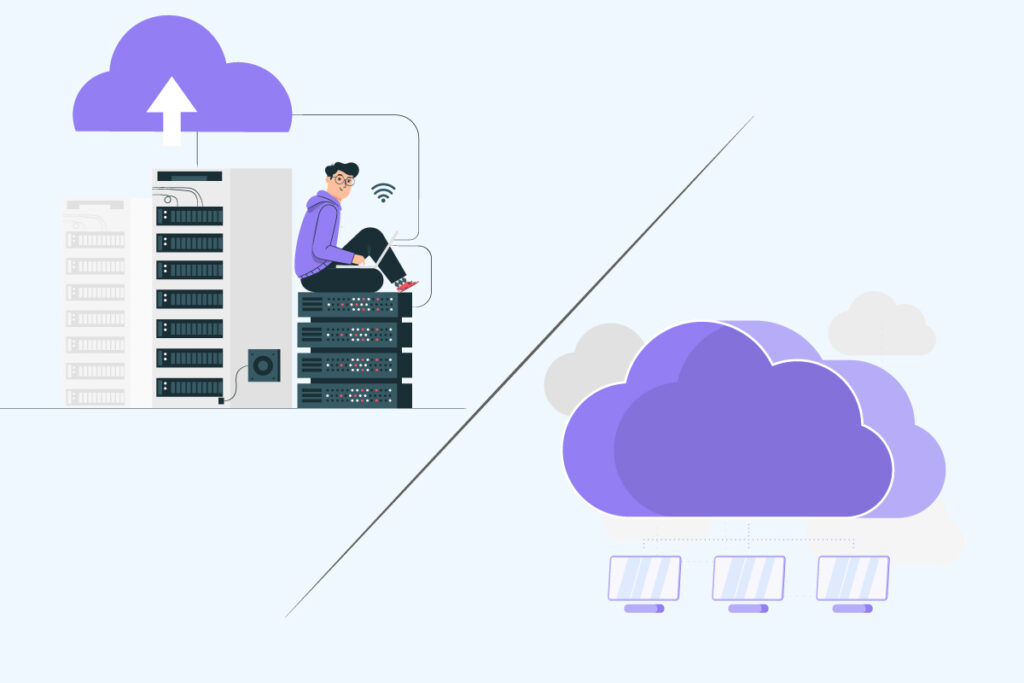Technology is always evolving, and it brings new options for businesses to improve their efficiency and lower costs. Two of the most popular options are cloud computing and virtualization. But which one is right for your organization?
For years, businesses have been struggling to choose between cloud computing and virtualization. In this post, we?ll break down the pros and cons of each technology so you can make an informed decision. We?ll also help you figure out which option is the best for your specific needs. Let?s get started!

What is Cloud Computing?
Cloud computing is a modern innovation that makes it possible to quickly provision and release a set of shared and reconfigurable computing resources (such as networks, servers, storage, and services) with little management work or service provider.
It is capable of accessing information and applications via the Internet. This can be done through a variety of devices, including laptops, tablets, and smartphones. In other words, cloud computing allows you to access what you need, and when and where you need it.
Public cloud, private cloud, and hybrid cloud computing are three categories of cloud computing.
What is Virtualization?
Virtualization can be a little difficult to define because it is used in so many different ways. Generally speaking, though, virtualization is the process of creating a virtual version of something.
In the technology world, virtualization has come to mean the use of software to create a virtual version of a physical server. This software-based approach allows companies to use fewer physical servers, saving them money on hardware and maintenance costs
Benefits of Cloud Computing
When it comes to cloud computing, the benefits are numerous. First and foremost, it’s incredibly scalable. That means that your organization can grow or shrink its cloud usage as needed without having to invest in new hardware or software.
Another big benefit is that data is stored off-site, so if there’s ever a disaster or emergency at your office, your data will still be safe. And since the cloud is always accessible, you and your team can work from anywhere in the world.
Another advantage is the concept of cloud computing for rural banking project that offers effective functionality.
Overall, cloud computing is a great option for businesses of all sizes and can save you time and money in the long run. If you’re not sure if it’s the right fit for you, contact us and we’d be happy to chat about your specific needs.
Drawbacks of Cloud Computing
Cloud computing has many benefits, but it also has drawbacks. If you are interested in moving your company to the cloud, you should be aware of the following considerations.
Different cloud service providers may achieve and maintain different levels of data protection and security. Choose your service provider wisely, making sure that they are reputable, stable, and offer fair terms and conditions of service.
Cloud computing works poorly if the connection is extremely slow. One of the most crucial factors we take into account before choosing cloud computing server service providers is the quality of the servers. We will suffer because of poor server quality when the server is down or the performance is bad.
Benefits of Virtualization
There are many benefits of virtualization, but some of the key advantages are that it can improve efficiency and save organizations money.
Virtualization can help businesses run more efficiently by consolidating servers and minimizing downtime. It also helps reduce energy consumption and server costs, making it a more cost-effective option for organizations.
In addition, virtualization can improve security and make it easier for businesses to manage their IT resources. Overall, virtualization is a powerful tool that can provide a number of benefits for organizations of all sizes.
Drawbacks of Virtualization
However, there are also some disadvantages to consider before making your decision. One of the biggest is that virtualization can be complex and difficult to manage, which can be a challenge for less-experienced IT staff. Additionally, it can be more expensive than traditional cloud computing.
Ultimately, the decision comes down to what will work best for your organization. If you’re looking for greater flexibility and scalability, cloud computing is probably the better option. If you’re more concerned about security and want more control over your infrastructure, virtualization may be the better choice.
Why Cloud Computing Is Better Than Virtualization?
Cloud computing has a lot of advantages over virtualization. The first is that it’s more scalable. With cloud computing, you can easily add or remove resources depending on your needs, which is great for businesses that are constantly growing and changing.
Another big advantage is that cloud computing is more affordable. With virtualization, you need to purchase and maintain hardware and software, which can be expensive. Cloud computing, on the other hand, is much more affordable because you only pay for the resources you use.
Lastly, cloud computing is more secure. Virtualization environments are often targeted by hackers because they’re seen as being easier to penetrate. Cloud computing environments are much more secure because they’re typically well-protected by the provider.
How to Implement Cloud Computing in Your Organization?
The first step is to understand your organization’s needs. What are you trying to achieve with your cloud deployment? What are your priorities?
Once you’ve identified your goals, it’s time to start planning your implementation. This phase will involve mapping out your current infrastructure, setting up governance and security protocols, and designing the cloud architecture.
It’s important to have a clear plan in place before you begin, as the process can be complicated and there are many things that can go wrong if you’re not careful. With the right preparation, however, cloud computing can be an incredibly powerful tool for your business.
How to Implement Virtualization in Your Organization?
If you’ve decided that virtualization is the right solution for your organization, the next step is actually implementing it. This can be a daunting task, but with the right resources in place, it can be a breeze.
First, you’ll need to create a plan for your virtualization deployment. This plan should include the following:
- The business goals you’re hoping to achieve with virtualization
- The infrastructure requirements of your organization
- The steps you’ll need to take to deploy virtualization
- The timeline for your deployment
Once you have a solid plan in place, it’s time to get started! Work with your IT team to begin installing the necessary software and configuring your servers. Be sure to test everything before going live with your new system.
Virtualization can be a great way to improve the efficiency and performance of your organization, but it’s important to choose the right solution and plan accordingly. With the right planning and execution, you’ll be on your way to enjoying all the benefits virtualization has to offer.
Making the Decision: Cloud Computing vs Virtualization
So, you’ve heard about cloud computing and virtualization and you’re not sure which one is right for your organization. We’re here to help!
Cloud computing is a type of computing where data and applications are hosted remotely, instead of locally on your computer. This means that you can access your files, applications, or entire operating system from any internet-enabled device.
Virtualization, on the other hand, is the process of creating a virtual copy of something, such as a server, desktop, or even an entire network. Having multiple virtual machines on a single physical machine can help you save on hardware costs and increase efficiency.
So, which one is right for you? If you’re looking for a more cost-effective way to manage your organization’s computing needs and want the flexibility to access your data from anywhere, then cloud computing would be the ideal choice.
If you’re looking for a way to improve efficiency and want more control over your organization’s infrastructure, then virtualization is the better option.
Conclusion
So, how do you decide which solution is best for your organization? Well, the first step is to assess your needs. What are your business priorities? What are your computing requirements? How much can you afford to spend?
When it comes to cloud computing and virtualization, there is no one-size-fits-all answer. Both have their own unique benefits and drawbacks, and the best way to decide which one is right for your organization is to assess your specific needs and requirements.
Cloud computing is a great option for businesses that need a lot of flexibility and scalability, as it allows you to easily add or remove resources as needed. Virtualization, on the other hand, is ideal for organizations that want more control over their IT environment and don?t need the flexibility that clouds computing offers.
After you?ve answered these questions, you can start to compare the features of cloud computing and virtualization. If you?re still not sure which option is right for you, get in touch with an expert. They can help you assess your needs and choose the right solution for your organization.
Ultimately, the best way to decide which one is right for you is to weigh the pros and cons of each and then make a decision based on your specific needs and requirements.

As the editor of the blog, She curate insightful content that sparks curiosity and fosters learning. With a passion for storytelling and a keen eye for detail, she strive to bring diverse perspectives and engaging narratives to readers, ensuring every piece informs, inspires, and enriches.









